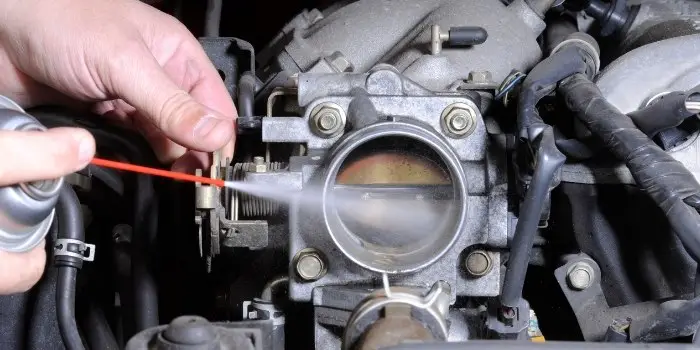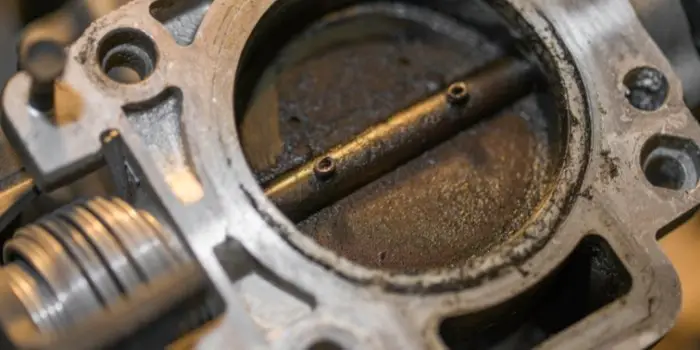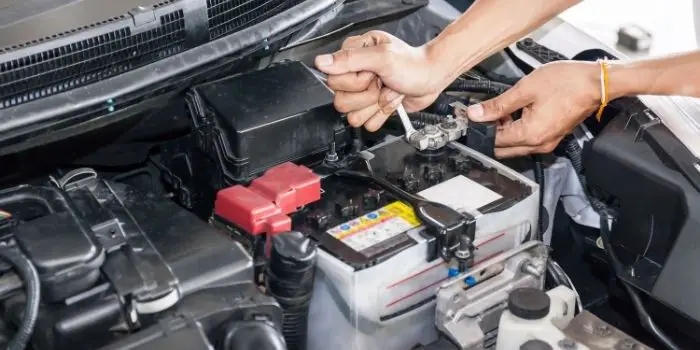
Between your air intake filter and pipes and your intake manifold is a throttle body.
The throttle body functions as a valve, limiting the quantity of air that enters the engine.
When you push the gas pedal, you are opening the throttle plate, enabling more air to enter the intake manifold and subsequently the engine.
The throttle body will get filthy with time, resulting in a loss of power.
Cleaning the throttle body is a simple chore that I believe everyone can do.
The best aspect is that you don’t have to disassemble the throttle body to clean it.
What are the Signs of a Clogged Throttle Body?
Several signs suggest that your throttle body needs to be cleaned.
Before we get into the symptoms, let’s explain what the throttle body is and why it is unclean.
Have you ever wondered what happens when you hit the gas pedal?
Let me explain in layman’s terms.
The throttle body is connected to the gas pedal through a mechanical wire or a sensor and actuator.
The throttle body moves in response to the movement of the gas pedal. It is in charge of the quantity of air that enters the engine.
Based on the quantity of air, the computer estimates the amount of fuel to inject.
The throttle body controls the quantity of air that enters the engine.
Excess carbon residues and debris precipitate on the throttle body during burning in the combustion chambers.
This then leads to the issues we’ll go into later.
Here are some of the indications of a filthy throttle body:
Stalling:
As previously mentioned, the ECU (engine control unit) decides how much fuel to inject into the combustion chamber depending on how much air is sucked in via the throttle body.
As a result, if the throttle body is filthy or clogged, the quantity of air required for proper operation is not injected, causing the engine to stall.
Unstable Idling:
To maintain smooth operation while idle, a sensor installed on the throttle body known as “idle control” is used.
This sensor must pull a specified quantity of air into the engine at idle to guarantee smooth operation.
If the throttle body is clogged or obstructed with dirt, this sensor will not function properly, and the automobile will not be steady on the idle.
As we go, you will discover how to clean a filthy throttle body sensor.
Rough Running:
A faulty or unclean throttle body may produce misfires as a consequence of a poor fule/air combination, resulting in rough running.

Step-by-Step Instructions for Cleaning the Throttle Body Without Removing It
Preparing the workstation is the first step towards cleaning the throttle body without removing it.
Because the compounds you will be using are volatile, this should be done outside in a well-ventilated area.
After deciding on a suitable location, you must locate the throttle body beneath the hood in the engine compartment.
Here are some pointers to help you find it quickly:
- The throttle body is located between the air cleaner and the intake manifold.
- The throttle body is made of aluminum.
- In some older models, the throttle body is connected to the gas pedal by a metal wire, allowing you to identify it by pressing the gas pedal while the engine is turned off and observing the moving part.
When you discover the throttle body, you must proceed with caution.
This is because it is linked to hoses, tubes, and, in certain circumstances, electrical connections.
Avoid some of these pieces since it will be tough to restore them to their original condition if anything goes wrong with them.
Materials and tools:
Before beginning this work, you must gather the necessary equipment and supplies, which include:
- Torx screwdriver set
- In the event of sticky grime and stains, use a soft toothbrush.
- To separate the clamps, use light pliers.
- Rubber gloves and safety goggles
- Throttle body cleaner – This is the most important section of this instruction. Choose this cleaning with caution to prevent hurting the internal components and sensors connected to the throttle body.
- Paper towel – Used to remove dirt and stains.
With the proper supplies and tools, you can now prepare the vehicle and equipment and begin the cleaning procedure.
Step 1:
To prevent any short circuits, disconnect the vehicle’s battery’s negative connection for safety.
Step 2:
Find the large air duct that runs from the throttle body to the air cleaner. It is often secured with a metal clamp.
Using a screwdriver, unscrew the screw and carefully remove the air duct. Take your time with this. Disconnect any electrical wires that are attached to the air duct.
Step 3:
Remove the air ducts and hoses to reveal the moveable plate within the throttle body. Take care not to harm any gaskets that may be within.
Step 4:
Put on your safety equipment, including rubber gloves and safety goggles.
Begin by spraying the throttle body cleaner inside the throttle body and using the brush to remove the sticky dirt. Take cautious not to spill any portions of the throttle body.
Step 5:
Repeat the preceding steps numerous times. Wipe away the dirt using a paper towel after each use.
Repeat the operation until the exposed metal is completely clean. Carefully remove the idle sensor, clean it, and properly dry it.
Step 6:
Wipe the throttle body dry with paper towels. Make certain that no liquid remains on the throttle body.
Step 7:
Replace the air ducts and tighten the clamps with a screwdriver or Torx screwdriver.
Step 8:
After you’ve reinstalled the air ducts and any electrical connections you’ve removed, remove your equipment and materials from the engine compartment and reconnect the battery negative terminal.
You may now start the engine.
Step 9:
It is typical to have issues such as starting the engine, stumbling, or unsteady RPM after cleaning the throttle body.
It is caused by throttle cleaner residues burning in the intake manifold. Everything will return to normal when it burns out.
Step 10:
If you’re wondering if cleaning the throttle body makes a difference, take your vehicle for a test drive and you’ll notice a change in engine performance, sound, and fuel efficiency.
This is the same method for cleaning the electronic throttle body.
Questions and Answers (FAQs)
Q. Is it necessary to clean the throttle body?
Sure. Cleaning the throttle body improves vehicle performance and drivability.
It is a remedy for everyone who is suffering rough engine running, unstable vehicle operation, and diminished vehicle performance when the car is still brand new.
Q. Is it possible to clean the throttle body while the engine is running?
Yes. The whole throttle cleaning solvent can enter the combustion chamber. This chemical is very damaging to gaskets and oil seals.
As a result, if these components are exposed to too much of this material, they may be damaged. It is safer to clean the throttle body when the engine is turned off.
Q. Which Throttle Body Cleaner Is the Best?
The best cleaners to use on your throttle body are special and certified throttle cleaners.
These cleansers are made from ecologically safe materials. The cleaners are not harmful to the engine’s internal components.
Q. Can I use carb cleaner on the throttle body?
Yes. You can use a carb cleaner, but it will not cling to the heavy grime. As a result, you will need to use more of it to remove all carbon buildups.
Q. How much does it cost to clean the throttle body?
Throttle body cleaning charges are not prohibitively expensive. A throttle body cleaner costs about $7 and may be used for three complete cleaning cycles.
Basic maintenance tools will also be required. As a result, cleaning your throttle body is not a costly task.
Q. Can I use WD40 to clean the throttle body?
WD40 is ineffective as a throttle body cleaning; stubborn deposits attached to the throttle body and throttle plate will need the use of a throttle body solvent.
A throttle body cleanser is designed to aid in the breakdown of carbon and other fuel-related deposits on the throttle body.
Q. Is it possible to clean the throttle body using a fuel system cleaner?
Because no gasoline passes through the throttle body, adding anything to the fuel tank does not influence the throttle body’s cleanliness.
Q. Will cleaning the throttle body improve idle?
While cleaning the throttle body is excellent preventive auto maintenance, it also improves engine drivability.
Indeed, if you’ve experienced not-so-smooth idle, sluggish starting acceleration, and even stopping when the engine is completely warmed up, filthy throttle body might be to blame.
Q. Is it possible for the throttle to produce white smoke?
Replaced the PCV valve, and now oil is passing through the throttle body and leaving via the exhaust, resulting in oil loss and white smoke emitted from the tailpipe.
Q. When should you clean the throttle body?
If your vehicle seems to be idling harsher or faltering during acceleration, it may be time to clean your throttle body.
Even if you are not experiencing any problems, complete cleaning of the throttle body is recommended every 70,000 miles to prevent these problems from occurring.
CONCLUSION
Finally, you should know how to clean the throttle body without removing it, how to identify whether the throttle body needs cleaning, and what equipment you’ll need.
You should realize that this is preventative maintenance performed to keep your automobile in top shape.
If cleaning your throttle body continues to be difficult, it is best to seek expert assistance.
If you are uncomfortable, do not continue with the procedure since you may end up hurting certain portions.
Remember to use safety eyewear to protect yourself from any harmful chemicals.

Based in Orem (Utah) John Paterson graduated from Utah Valley University and has begun writing in 2009. He has a large wealth of experience in writing articles related to cars, automotive repair, wheels, cleaning/maintenance, and much more. He has also written instructional articles in a similar niche for a few online publications as well. Currently, he works as a mechanic in his personal garage shop where he loves serving his countrymen from his heart.




